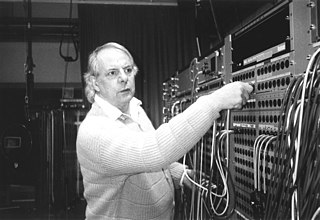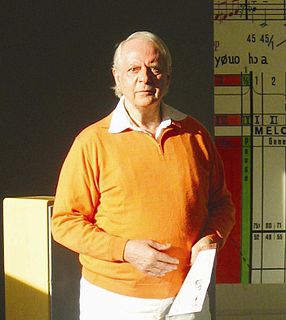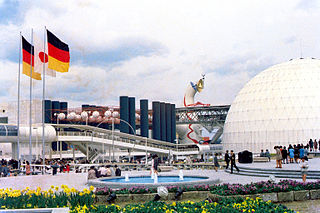
Karlheinz Stockhausen was a German composer, widely acknowledged by critics as one of the most important but also controversial composers of the 20th and early 21st centuries. He is known for his groundbreaking work in electronic music, for introducing controlled chance into serial composition, and for musical spatialization.

Inori, for one or two soloists with orchestra, is a composition by Karlheinz Stockhausen, written in 1973–74.

Licht (Light), subtitled "Die sieben Tage der Woche", is a cycle of seven operas composed by Karlheinz Stockhausen between 1977 and 2003. The composer described the work as an "eternal spiral" because "there is neither end nor beginning to the week." Licht consists of 29 hours of music.
Gruppen for three orchestras (1955–57) is amongst the best-known compositions of German composer Karlheinz Stockhausen, and is Work Number 6 in the composer's catalog of works. Gruppen is "a landmark in 20th-century music ... probably the first work of the post-war generation of composers in which technique and imagination combine on the highest level to produce an undisputable masterpiece".

Kontakte ("Contacts") is an electronic music work by Karlheinz Stockhausen, realized in 1958–60 at the Westdeutscher Rundfunk (WDR) electronic-music studio in Cologne with the assistance of Gottfried Michael Koenig. The score is Nr. 12 in the composer's catalogue of works, and is dedicated to Otto Tomek.

The Klavierstücke constitute a series of nineteen compositions by German composer Karlheinz Stockhausen.

Hymnen is an electronic and concrete work, with optional live performers, by Karlheinz Stockhausen, composed in 1966–67, and elaborated in 1969. In the composer's catalog of works, it is No. 22.
Carré (Square) for four orchestras and four choirs (1959–60) is a composition by the German composer Karlheinz Stockhausen, and is Work Number 10 in the composer's catalog of works.

Dienstag aus Licht is an opera by Karlheinz Stockhausen in a greeting and two acts, with a farewell, and was the fourth of seven to be completed for the opera cycle Licht: Die sieben Tage der Woche. It was begun in 1977 and completed from 1988 to 1991, to a libretto by the composer.

Musik im Bauch is a piece of scenic music for six percussionists and music boxes composed by Karlheinz Stockhausen in 1975, and is Number 41 in his catalog of works. The world premiere was presented on 28 March 1975 as part of the Royan Festival. The performance was given by Les Percussions de Strasbourg in the haras in the town of Saintes, near to Royan. Its duration is roughly 38 minutes.
Studie II is an electronic music composition by Karlheinz Stockhausen from the year 1954 and, together with his Studie I, comprises his work number ("opus") 3. It is serially organized on all musical levels and was the first published score of electronic music.
Studie I is an electronic music composition by Karlheinz Stockhausen from the year 1953. It lasts 9 minutes 42 seconds and, together with his Studie II, comprises his work number ("opus") 3.

Fresco is an orchestral composition written in 1969 by the German composer Karlheinz Stockhausen as foyer music for an evening-long retrospective programme of his music presented simultaneously in three auditoriums of the Beethovenhalle in Bonn. It is Nr. 29 in his catalogue of works, and a performance takes about five hours.

Pole (Poles), for two performers with shortwave radio receivers and a sound projectionist, is a composition by Karlheinz Stockhausen, written in 1970. It is Number 30 in the catalogue of the composer's works.

Harlekin (Harlequin) is a composition for unaccompanied clarinet by Karlheinz Stockhausen, named for the commedia dell'arte character Harlequin. It was composed in 1975 and is Number 42 in his catalogue of works. A shorter, derived work called Der kleine Harlekin is Number 42½.

Stop is a composition for orchestra by Karlheinz Stockhausen, work-number 18 in the composer’s catalogue of works, where two performing realisations are also found as Nr. 18½ and Nr. 18⅔.

Oktophonie (Octophony) is a 1991 octophonic electronic-music composition by Karlheinz Stockhausen. A component layer of act 2 of the opera Dienstag aus Licht, it may also be performed as an independent composition. It has a duration of 69 minutes.
Unsichtbare Chöre is an eight-channel electronic-music composition by Karlheinz Stockhausen. A component part of the opera Donnerstag aus Licht, it may also be performed as an independent composition, in which form it is designated "ex 49" in the composer's catalog of works.

Expo, for three performers with shortwave radio receivers and a sound projectionist, is a composition by Karlheinz Stockhausen, written in 1969–70. It is Number 31 in the catalogue of the composer's works.

Musik für ein Haus is a group-composition project devised by Karlheinz Stockhausen for the 1968 Darmstädter Ferienkurse. Fourteen composers and twelve instrumentalists participated, with the resulting performance lasting four hours. It was not regarded by Stockhausen as a composition belonging solely to himself, and therefore was not assigned a number in his catalog of works.
















